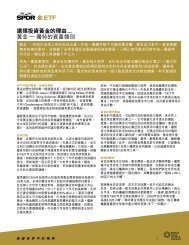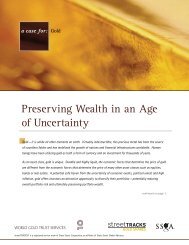Create successful ePaper yourself
Turn your PDF publications into a flip-book with our unique Google optimized e-Paper software.
Why consider a non-US dollar numéraire?Past optimal-allocation studies have found a clear role for gold incentral-bank reserve portfolios, although until now such studieshave largely been confined to US-dollar-based portfolios. 4However, a foreign-reserve manager could extend a US dollarbasedoptimisation to a domestic currency (non-US dollar)perspective in order to: 1) reduce the bias of their dollar-basedanalysis; 2) assess efficiency/robustness of the analysis in thedomestic currency; and 3) consider how the changing nature oftheir domestic currency’s relationship to the dollar may affectthe results.First, addressing the numéraire bias, the Reserve Bankof Australia has noted that a portfolio consisting of assetsexpressed in the study’s numéraire would involve no currencyrisk and thus possess the lowest risk profile. 5 The results wouldlead to portfolio allocations biased to numéraire-denominatedassets and, potentially, improper portfolio diversification. 6Second, reserve managers need to be mindful of their portfolioperformance from a domestic-currency perspective. This maybe due to concern or interest from government officials and thepublic in maximising profits, especially as central banks typicallyreport foreign holdings in local-currency terms. It may also stemfrom the central bank’s need to pay local-currency liabilities and/or rely on interest income or profits to sustain its operations.Finally, a change in the numéraire in optimisation exercises helpsreserve managers understand the potential changing role oftheir currency vis-a-vis other reserve currencies, with particularattention on the US dollar. A declining role for the US dollar asthe primary reserve currency could lead to its increased volatilityversus emerging-market currencies. This consideration isparticularly relevant when changes to foreign-exchange policieslead to more flexible regimes. For example, moving from afixed exchange rate (relative to the US dollar) to a more flexibleregime will introduce greater volatility against the domesticcurrency and other reserve currencies. In this case, a domesticcurrencyanalysis would be more fruitful, providing greaterinsight into how a foreign-reserve portfolio should evolve.4 Several past studies have found some role for gold in a reserve asset portfolio with differing degrees of allocation. See: Scacciavillani and Saidi,The case for gold as a reserve asset in the GCC (Dubai: Dubai International Financial Centre, 2010); Natalie Dempster, The importance of gold as a reserveasset, World <strong>Gold</strong> Council, 2010; Carlos León and Daniel Vela, Strategic asset allocation: non-loss constraints and long-term dependence, in RBS ReserveManagement Trends 2011, ed. R. Pringle and N. Carver (London: Central Banking Publications, 2011). Other studies have often excluded gold in theiroptimisation analysis for example: see Elias Papaioannou, Richard Portes and Gregorious, Optimal currency shares in international reserves: The impact ofthe euro and the prospects for the dollar (NBER Working Paper no.12333, June 2006).5 Reserve Bank of Australia Foreign Reserves Management available from http://www.rba.gov.au/mkt-operations/mgmt-foreign-curr/perf-measuremt.html,accessed in December of 2011.6 The analysis conducted in emerging-market currencies resulted in no significant allocation to any one particular asset/currency as was found in theUS dollar analysis, with its bias toward US dollar assets.<strong>Gold</strong> <strong>Investor</strong> | Risk management and capital preservation










